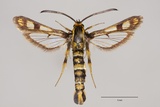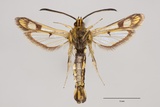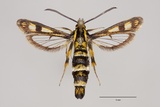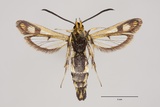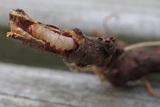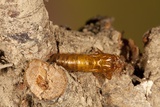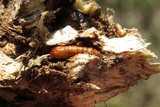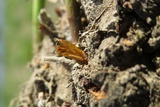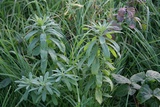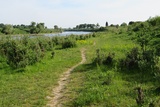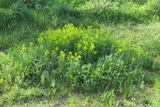Chamaesphecia tenthrediniformis (Denis & Schiffermüller, 1775) Species
Last modified: May 7, 2024, 11:55 a.m.
This is a local species in Belgium, only known from two provinces in the eastern part of the country.
This species is considered Endangered according to the IUCN Red List category for Flanders 2023.
Details
- Classification
- Family: Sesiidae > Subfamily: Sesiinae > Tribus: Synanthedonini > Genus: Chamaesphecia > Species: Chamaesphecia tenthrediniformis
- Vernacular names
- Wolfsmelkwespvlinder (NL), Sésie tenthrède (FR), Eselswolfsmilch-Glasflügler (DE)
- First mention in Belgium
- De Sélys-Longchamps E. 1844. Énumération des insectes Lépidoptères de la Belgique. — Mémoires de la Société royale des Sciences de Liége 2: 1–35. On page 6 (as Sesia tenthrediniformis). view page
- Status
-
Native
Distribution
Imago
Ch. tenthrediniformis is very variable in size and ranges from 12 mm to 21 mm. It has a golden-yellow appearance and the external transparent area (ETA) on the forewing is usually circular and generally consists of 4 cells. There are notable golden-yellow coloured scales between the veins in the apex of the forewing. The brown abdomen has a lot of yellow scales forming diffuse rings that are bordered distally with white on some segments. The anal tuft is black with yellow and is different in males and females. The proboscis is, as in all species of this genus, well developed and functional. This species belongs, together with Ch. empiformis, to a so called cryptic species group. This means these species can not be distinguished from each other based on morphological characters. Examination of the genital structures does not show a useful distinction either but flight behaviour and pheromone response are completely different in both species (see 'Bionomics'). The males are very well attracted to the pheromone originally developed for Synanthedon myopaeformis and are best lured from noon till late in the afternoon but the optimal time span is very weather dependent.
Genitalia
The genitalia structure is not meaningfully different from that of Ch. empiformis.
Egg
The black eggs are elliptically shaped and clearly smaller than the eggs of Ch. empiformis, its sibling species.
Mine
The larva constructs a central gallery inside the root of its hostplant.
Bionomics
Females deposit their eggs on the upperside and the underside of the leafs of the hostplant but literature also mentions ovipositing is observed on the stem at the leafless base of the plant. Strong and well developed plants, having a root and stalks with a sufficient diameter, appear to be preferred and sometimes several larvae can occur together in one root. The young larvae initially live in the upper part of the rootstock but construct, later on, a gallery deeper into the root. A substantial amount of frass is often extruded and clearly visible at the base of the infested plant. This is a completely different behaviour compared to Ch. empiformis which rarely expels frass. The caterpillar hibernates full-grown inside its gallery and, in springtime, often constructs a short exit tube towards ground level. The pupation occurs inside this tube or in the upper part of the gallery after preparing a future exit hole. The adults hatch about 3–4 weeks later. Consequently, this species completes its development in one year. Besides having a different hostplant, this species also displays other behavioural differences with Ch. empiformis: the latter is a very fast and nervous flier with a very skittish demeanour while Ch. tenthrediniformis is a slow flying and calm species that can easily be observed sitting on its hostplant. Furthermore both species react on a completely different pheromone composition.
Flight periods
The adults predominantly fly in May and June. The flight period is therefore slightly earlier than that of his congener Ch. empiformis.
Observed on
- Host plant (species):
- Euphorbia esula
In Belgium, the larva is restricted to Euphorbia esula but in Central Europe also Euphorbia salicifolia is infested.
